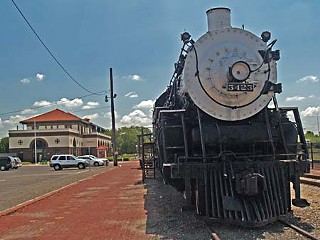Day Trips
Harvey Houses helped settle the West and were the travelers' best friend for 92 years
By Gerald E. McLeod, Fri., Aug. 27, 2010
Harvey Houses helped settle the West and were the travelers' best friend for 92 years. A few reminders of these once-popular restaurants, lunchrooms, and hotels remain in Texas.
In his entertaining and informative book Appetite for America, author Stephen Fried documents the rise and fall of the Fred Harvey Co. as it rode the rails of the Santa Fe Railroad. In 1875, the 40-year-old traveling salesman invested in two railroad eating houses. From these eateries, Fred, his son Ford, and his grandson Freddy built the first restaurant chain in America. Of the 155 locations, 21 were in Texas.
Fred Harvey revolutionized hospitality service in many ways. The most obvious was that his restaurants served quality food and fresh vegetables at a time when most roadhouses fried everything. Harvey insisted on high standards of cleanliness and efficiency, and personally inspected his properties. He was known to pull the white tablecloth off a table, scattering the custom-made dishes, when something didn't meet his exacting standards.
At first the restaurants employed black waiters, but racial tensions between the waiters and Confederate veterans often resulted in violence. In Raton, N.M., the manager hired an all-female waitstaff, and the Harvey Girl legend began. Not only did the waitresses have a calming effect on rowdy customers, but they helped populate the Southwest, where women were scarce.
Besides being popular with train passengers, the restaurants were often the favorites of area residents. The larger eateries were spaced so that passenger trains would arrive at mealtime. Passengers were given 20 to 30 minutes to eat while the train refueled. Quite often, locals were left waiting while passengers were given priority service.
Of the surviving depots, the largest of the Harvey Houses in Texas was in Temple. The company also had a dairy and vegetable farm outside of town that supplied the chain. The former depot is now the Santa Fe Depot Railroad and Heritage Museum at 315 W. Avenue B, which includes a small display of Harvey House memorabilia.
In Brownwood, the former Harvey House is now used by the local chamber of commerce. It's open on weekdays, and there's an exhibit of a Harvey Girl bedroom.
The Harvey House in Slaton, 30 miles south of Lubbock, survived for 30 years until it closed in 1942. The old Santa Fe depot has been beautifully restored as a lunchroom and event center with overnight accommodations in the rooms once occupied by the Harvey Girls.
In Gainesville, the Harvey House is now a local museum with an exhibit on the depot's role in the restaurant chain. In Galveston, the art deco building that once housed the Union Depot is now the Railroad Museum with an extensive collection of items from the Harvey days.
Other depots that once housed Fred Harvey enterprises in Texas survive in Amarillo, Fort Worth, and Paris.
998th in a series. Day Trips, Vol. 2, a book of "Day Trips" 101-200, is available for $8.95, plus $3.05 for shipping, handling, and tax. Mail to: Day Trips, PO Box 33284, South Austin, TX 78704.









